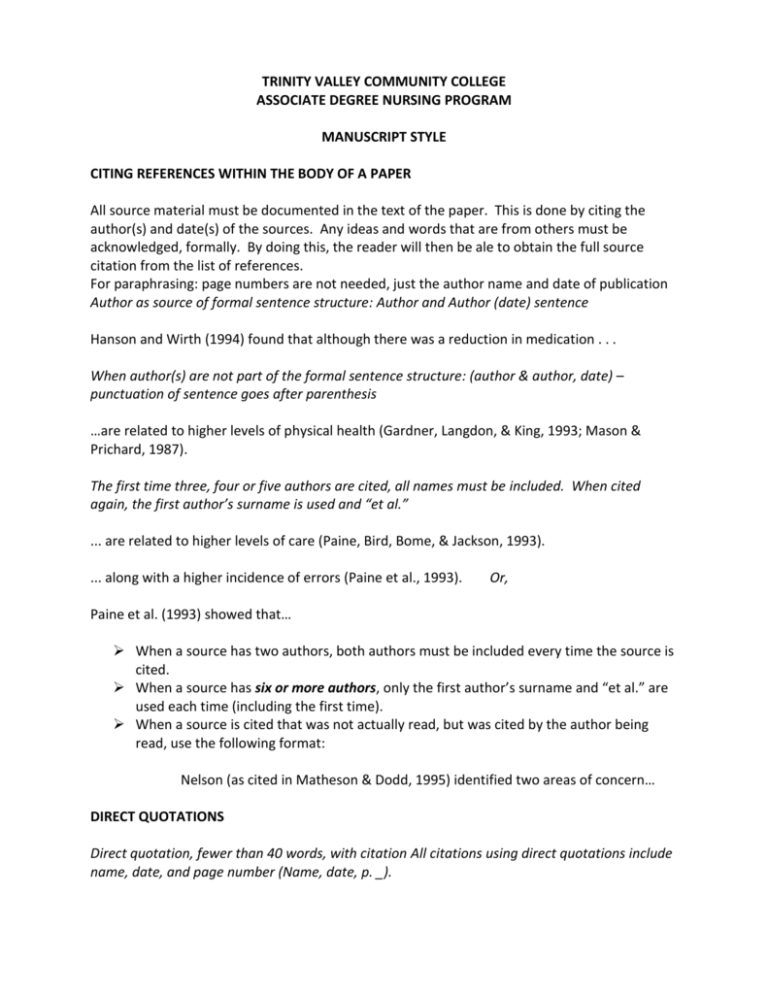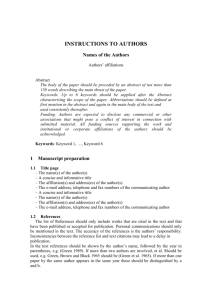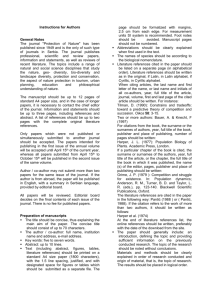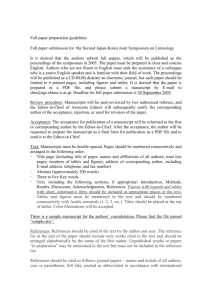TRINITY VALLEY COMMUNITY COLLEGE
advertisement

TRINITY VALLEY COMMUNITY COLLEGE ASSOCIATE DEGREE NURSING PROGRAM MANUSCRIPT STYLE CITING REFERENCES WITHIN THE BODY OF A PAPER All source material must be documented in the text of the paper. This is done by citing the author(s) and date(s) of the sources. Any ideas and words that are from others must be acknowledged, formally. By doing this, the reader will then be ale to obtain the full source citation from the list of references. For paraphrasing: page numbers are not needed, just the author name and date of publication Author as source of formal sentence structure: Author and Author (date) sentence Hanson and Wirth (1994) found that although there was a reduction in medication . . . When author(s) are not part of the formal sentence structure: (author & author, date) – punctuation of sentence goes after parenthesis …are related to higher levels of physical health (Gardner, Langdon, & King, 1993; Mason & Prichard, 1987). The first time three, four or five authors are cited, all names must be included. When cited again, the first author’s surname is used and “et al.” ... are related to higher levels of care (Paine, Bird, Bome, & Jackson, 1993). ... along with a higher incidence of errors (Paine et al., 1993). Or, Paine et al. (1993) showed that… When a source has two authors, both authors must be included every time the source is cited. When a source has six or more authors, only the first author’s surname and “et al.” are used each time (including the first time). When a source is cited that was not actually read, but was cited by the author being read, use the following format: Nelson (as cited in Matheson & Dodd, 1995) identified two areas of concern… DIRECT QUOTATIONS Direct quotation, fewer than 40 words, with citation All citations using direct quotations include name, date, and page number (Name, date, p. _). Patients receiving spiritual support had “less readmissions to the hospital, required less antibiotic therapy, less diuretic therapy, had fewer episodes of cardiac arrests and pneumonia, had less respiratory distress, less congestive heart failure” (Carson, 1988, p. 756). Quotations 40 words or greater must appear (without quotation marks) in block format with each line indented five spaces from the left margin, and apart from the surrounding text. Personal communications: (Name, personal communication, date). Cited in paper only and not in the reference list. Personal communications can include letters, memos, emails, telephone or text communications. REFERENCE LIST Written work completed in the nursing program is to follow the manuscript style guidelines set forth in the Publication Manual of the American Psychological Association (APA), 5th edition. Nursing care plans and other papers shall follow these guidelines. The use of resources without proper citation is plagiarism and is unethical. The reading lists in the syllabi are examples of the APA style. The following pages give directions for using APA style. I. PERIODICALS Elements of reference to a periodical Thomas, M. B. (2010). Registered nurses select multiple factors associated with their errors. Critical Care Nursing Clinics of North America, 22, 279-282. doi: 10.1016/j.ccell.2010.03.010 Article authors: Thomas, M. B. Invert all authors’ names; gives surnames and initials for all authors, regardless of the number of authors. Use a comma to separate authors and to separate surnames and initials; with two or more authors, use an ampersand (&) before the last author. Spell out the name of a corporate author. When referencing a work with no author, move the title to the author position, before the date of the publication, and treat the title like a book title (refer to elements of a reference to an entire book). Finish the element with a period. In a reference to a work with a corporate author, the period follows the corporate author. In a reference to a work with no author, the period follows the title, which is moved to the author position. (When an author's initial with a period ends the element, do not add an extra period.) All reference entries should have a hanging indent. References should all be double-spaced. (Bibliographies behind units in the syllabus and in these examples are single spaced to conserve space.) Date of Publication: (2010). Give the year the work was copyrighted (for unpublished works, give the year produced). When giving the date for magazines and newspapers, give the year followed by the month and day. Enclose the date in parentheses. A period is placed after the closing parentheses. If there is no publication date, use “n.d.” in parentheses following the authors. Article Title: Registered nurses select multiple factors associated with their errors. Only the first word of the title and subtitle (if any) is capitalized and any proper names. The title is not underlined nor placed in quotation marks. Use Arabic numerals in two-part titles unless the title is published using Roman numerals. The element is finished with a period. Critical Care Nursing Clinics of North America, 22, 279-282. The journal title is written in full, in uppercase and lowercase letters. The volume number is given. The number is not preceded by the word "Vol.". The journal title and volume number is italicized, unless using a typewriter instead of a word processing program, then underline the text to be italicized (with a continuous line). If each issue of the journal begins on page 1, give the issue number in parentheses immediately following the volume number. Specify inclusive page numbers. Use "pp." before the numbers only when referencing a daily newspaper article. Use commas to separate the parts of this element. Complete the element with a period. Digital object identifier: doi: 10.1016/j.ccell.2010.03.010 Include the digital object identifier (DOI) in the reference if one is assigned. A period does not go after a doi. If there is no DOI assigned and the reference was retrieved online, give the URL of the journal home page. Examples of References to Periodicals 1. Journal article, one author Blickstein, I. (1990). The twin-twin transfusion syndrome. Obstetrics and Gynecology, 76, 714-722. 2. Journal article, one author, journal paginated by issue Vickers, M. J. (1993). Understanding obesity in women. Journal of Obstetric, Gynecologic, and Neonatal Nursing, 22(1), 17-23. 3. Journal article, two authors Needleman, H., & Schell, A. (1990). Deficits in psychological and classroom performance of Of children with increased dentine lead levels. New England Journal of Medicine, 300, 689-895. 4. Journal article, two authors, journal paginated by issue Diaz, A. L., & McMillin, J. D. (1991). A definition and description of nurse abuse. Western Journal of Nursing Research, 13(1), 97-101. 5. Journal article, more than two authors Price, J. H., Desmond, S. M., Ruppert, E. S., & Stelzer, C. M. (1987). School nurse's perceptions of childhood obesity. Journal of School Health, 57, 332-336. 6. Journal article, more than two authors, journal paginated by issue Pigeon, H., McGarth, P., Lawrence, J., & MacMurray, S. (1989). Nurse's perceptions of pain in the neonatal intensive care unit. Journal of Pain and Symptom Management, 4(4), 179183. 7. Magazine Article Beck, M., Hager, M., Rogers, P., Miller, S., Rosenberg, D., & Snow, K. (1993, April 5). Doctors under the knife. Newsweek, 121, 28-33. 8. Newspaper article, no author When child day-care becomes night-care. (1993, June 1). The Dallas Morning News, p. 7C. Alphabetize articles that do not specify an author by the first significant word within the title. 9. Newspaper article, discontinuous pages Harper, S. (1993, May 31). New ammo in war on migraines. The Dallas Morning News, pp. 5C, 9C. If the pages of a newspaper article are discontinuous, give all the page numbers and separate the numbers with a comma. Example Reference of a Film and Guidelines for Nonprint Media Wild, K. E. (Producer), & Martin, N. J. (Director). (1993). Interpretation of laboratory Diagnostic test [Film]. Delran, NJ: Parke-Davis. The name(s) are given. Following each name, in parentheses, give the function of the originator or primary contributors (i.e. producer, director) The medium (all nonprint media including film, videotape, audiotapes, slides, charts, and artwork) is specified in brackets immediately after the title. The location and name of the distributor is given. II. BOOKS Elements of reference to an entire book Vallerand, A. H., & Deglin, J. H. (1991). Nurse's guide for IV medications. Philadelphia: Davis. Book authors or editors: Vallerand, A. H., & Deglin, J. H. Refer to elements of reference to a periodical. For books with corporate authors, alphabetize the corporate authors by the first important word of the name. When the publisher and author are the same, use the word Author as the name of the publisher. For an edited book, place the editor's names in the author's position. After listing the last editor's name, enclose the abbreviation "Ed." or "Eds." in parentheses. Complete the element with a period. When referencing an edited book, the period follows the parenthetical abbreviation "Ed.". Date of publication: (1991). Refer to elements of reference to a periodical. Book title: Nurse's guide for IV medications. Capitalize only the first word of the title and of the subtitle, if any, and any proper names or abbreviations. The title is underlined. Additional information necessary for identification of the book (e.g. 2nd ed. or Vol. 5) is enclosed in parentheses immediately after the title. A period does not separate the title and this information. Use Arabic numbers, not Roman numerals in two part titles unless Roman numerals are part of the published title. Complete the element with a period. Publication information: Philadelphia: Davis. Record the city, and only if the city is not well known for publishing or could be confused with another location, record the state or country. The name of the publisher is given in as brief a form as possible. The entire word should be spelled out for names of associations and university presses, but omit unnecessary terms such as Co., Publisher, or Inc. When two or more publishing locations are listed, give the location listed first in the book. The element is ended with a period. Examples of References to Entire Books and Articles or Chapters within Edited Books 1. Book, corporate author, third edition, author as publisher. American Psychiatric Association. (1994). Diagnostic and statistical manual of mental disorders (4th ed.). Washington, DC: Author. 2. Edited book Burish, T., & Bradley, L. (Eds.). (1993). Coping with chronic disease: Research and application. New York: Academic press. 3. Book, no author or editor Stress management techniques for college students. (1993). Austin, TX: College Board Press. 4. Article or chapter within an edited book Langston, R. A. (1990). Comparative effects of baccalaureate and associate degree educational Programs on the professional socialization of nursing students. In N.L. Chaska (Ed.), The nursing profession: Turning points (pp.53-58). St. Louis: Mosby. When referencing an article or chapter within an edited book the article or chapter authors, date of publication, and article or chapter title are the same as for referencing a single article, but there are some differences to be aware of. When the editor is not in the author position, the name of the editor is not inverted. The editor's initials are given followed by the surname. The initials and surnames for all editors are given, regardless of the number of editors listed. When two names are given, use an ampersand (&) between the two names and do not use a comma to separate the names. With three or more editors, use an ampersand before the last name and use commas to separate all names. Use parentheses and "pp." to give the article or chapters inclusive page numbers which is followed by a period. An example: (pp. 25-32). Publication information is the same as for referencing an entire book. III. ELECTRONIC MEDIA On-line sources Author, I. (date). Title of article. Name of Periodical, xx, xxx-xxx. Retrieved month day, year, from source. An availability statement is used to indicate that the URL leads to information on where to retrieve the cited material, rather than leading to the material itself. A retrieval date is only needed if the material is likely to change. Land, T. (1996, November 25). Web extension to American Psychological Association Style (WEAPAS) (Rev.1.4) [WWW document]. Available from National Technical Information Service Web site, http://www.beadsland.com/weapas/ Author Use all links to try to identify author of document. If someone maintains document, use modifier (Maint.) or (Ed.) after name. If documents represent an organization, treat the organization as a group or corporate author. If no reference to an author is found, an e-mail address, if given, can fill the author position of the reference. Date If the periodical is a recognized journal, use year, volume and issue number as usual. For an article in a monthly serial which will not be modified, the year and month should be listed (1996, September). Documents which are likely to change unpredictably over time and be update or modified should list the year followed by the month and day (1996, September 30). Documents that have no information as to when they were created or modified are treated as republished versions of works with no date of initial publication with the year being the year when the document was reviewed (n.d./1997). Title Title should be recognizable. Many clients post title at top left of printed document. Type of Document The nature of the document should be given in brackets immediately following the title. Examples: [WWW document] [FTP archive] [Gopher menu]. Author, I. (date). Title of document. [Type of document]. Publication information. Publication information URL – The URL (uniform resource locator) is the most important part of the electronic media reference. If it is incorrect, readers will not be able to locate the cited material. Do not add other punctuation. A URL can be broken at a slash, keeping the slash as the last character on the line. Example: http://www.beadsland.com/weapas/ Examples of electronic sources: 1. WWW document on department Web site or university program Harris, D., & Fogleman, M.L. (2000). APA guidelines. Retrieved May 12, 2000, from Winston University, Department of Psychology Web site: http://www.winston.edu/psychology/index.dfm?doc_id=897&mtsp; The guidelines are likely to change so a retrieval date is needed. 2. Journal article from database Stein, D., & Journeyman, T. (2000). A closer look at workplace violence. Journal of Interpersonal Violence, 13, 503-522. Retrieved from ProQuest database. The article will not change material so a retrieval date is not needed. 3. Stand alone Web document (no date) Jackson, M.E. (n.d.). Notable people in nursing. Retrieved August 10, 2001, from http://www.psywww.dom/psyrelig/psynurs.html 4. Stand alone Web document (no author, no date) Gender and psychology. (n.d.). Retrieved December 5, 2001, from http://www.trinity.edu/~kmlear/gender.html For more detailed information about citing on-line references, go to http://www.apastyle.org/elecref.html IV. PERSONAL COMMUNICATIONS Personal communications are not included in the reference list since they do not provide recoverable data. They are to be cited in the text only. Personal communications include personal interviews, telephone conversations, memos, letters, and some electronic communications. The initials, as well as the surname of the communicator must be included, along with as exact date as possible. J. T. Dukes (personal communication, April 3, 2001) (G. H. Danner, personal communication, September 21, 1999) f:\\syllabus\handbook\APA Format.doc Revised 03/13








